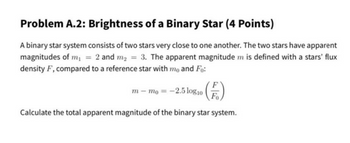Question
Calculate the total apparent magnitude of the binary star system.

Transcribed Image Text:Problem A.2: Brightness of a Binary Star (4 Points)
A binary star system consists of two stars very close to one another. The two stars have apparent
magnitudes of m₁ = 2 and m₂ = 3. The apparent magnitude m is defined with a stars' flux
density F, compared to a reference star with mo and Fo:
m-mo = -2.5 log10 Fo
Calculate the total apparent magnitude of the binary star system.
Expert Solution
This question has been solved!
Explore an expertly crafted, step-by-step solution for a thorough understanding of key concepts.
Step by stepSolved in 3 steps

Knowledge Booster
Similar questions
- Calculate the absolute magnitude of a star at a distance of 6 pc with an apparent magnitude of 3.arrow_forwardThe sketch below shows an H-R diagram for a star cluster. Consider the star to which the arrow points. How is it currently generating energy? Temperature A. by hydrogen shell burning around an inert helium core B. by gravitational contraction C. by core hydrogen fusion D.by core helium fusion combined with hydrogen shell burning E. by both hydrogen and helium shell burning around an inert carbon core Luminosity -→arrow_forwardWhat is the size of a star with a temperature three times as hot as the sun and the luminosity of 100 suns? (L=R^2T^4)arrow_forward
- The mass-luminosity relation describes the mathematical relationship between luminosity and mass for main sequence stars. It describes how a star with a mass of 4 M⊙ would have a luminosity of ______ L⊙. If a star has a radius 1/2 that of the Sun and a temperature 4 that of the Sun, how many times higher is the star's luminosity than that of the Sun? (If it is smaller by a factor of 8, you would write 0.125 because 1/8=0.125) If a star has a radius 2 times larger than the Sun's and a luminosity 1/4th that of the Sun, how many times higher is the star's temperature than that of the Sun? (If it is smaller by a factor of 8, you would write 0.125 because 1/8=0.125) If a star has a surface temperature 2 times lower than the Sun's and a luminosity the same as the Sun, how many times larger is the star than the Sun? (If it is smaller by a factor of 8, you would write 0.125 because 1/8=0.125)arrow_forwardMatch the spectral type and luminosity class to theletters shown on the Hertzsprung-Russell diagram 1) A WD (White Dwarf)2) G V (Main Sequence) 3) M V (Main Sequence)4) M I (Supergiant)5) G III (Giant)arrow_forwardTwo stars with the same luminosity form a close binary pair. Show that when they are observed together, the combined apparent magnitude is 0.75 mags less (i.e. brighter) than the sum of the individual magnitudes.arrow_forward
- This star has a mass of 3.3 MSun. What is the main sequence lifetime of this star? You may assume that the lifetime of the sun is 1010 yr.arrow_forwardOne way to calculate the radius of a star is to use its luminosity and temperature and assume that the star radiates approximately like a blackbody. Astronomers have measured the characteristics of central stars of planetary nebulae and have found that a typical central star is 16 times as luminous and 20 times as hot (about 110,000 K) as the Sun. Find the radius in terms of the Sun’s. How does this radius compare with that of a typical white dwarf?arrow_forwardA star has an apparent magnitude of 10 and an absolute magnitude of 2.5. How far is it?arrow_forward
- Zebulon is a binary star system composed of a 10 M sun main sequence star and a 1 M sun red giant. Is this strange? yes or no. explain the reasoning.arrow_forwardCalculate the mass of a star having a diameter of 6E5 km and an average density of 1.1 g/cm3arrow_forwardA Type Ia supernova is observed and achieves an apparent magnitude of m = 19.89 at peak brightness. The absolute magnitudes of Type Ia supernovae at peak brightness are known to be M=−19. Determine the distance to the supernovae in units of Mpc.arrow_forward
arrow_back_ios
SEE MORE QUESTIONS
arrow_forward_ios